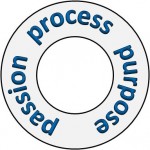 The wetware between our ears is both amazing and frustrating.
The wetware between our ears is both amazing and frustrating.
One of the amazing features is how we can condense a whole paradigm into a few words; and one of the frustrating features is how we condense a whole paradigm into a few words. Take the three words – Passion, Process and Purpose – just three seven letter words beginning with P. Together they capture the paradigm of Improvement Science – these are the three interdependent parts.
Passion provides the energy to change and the desire to do something. Purpose is the goal that is sought; the outcome that is desired. Process is the recipe, the plan, the map of the journey. All three are necessary and only together they are sufficient.
The easier bit is Passion – we are all emotional beings – we are not rocks or clocks – we have some irrational components included in our design. Despite what we may think, most of our thinking is outside awareness, unconscious, and we are steered by feelings and signal with feelings. We are not aware of how we use emotions to filter data and to facilitate decisions and we are not aware how we broadcast our unconscious thinking in our body language.
The trickier bit is Process and Purpose – not because they are difficult concepts, but because we confuse the two. There are two different questions that we use to use to try to separate them: the How and the Why questions. “How?” is the question that asks about the Process; “Why?” is the question that asks about the Purpose – and we very often give a How answer to a Why question. We seem to habitually dodge the Purpose question – and that is what makes it tricky. Asking the question “What is my purpose for …” is one that we find difficult to answer. It is difficult because our purpose is unconscious – it is a combination of many things combining in parallel – and such multi-part-interdependent-mental objects are systems; and systems are difficult to capture with a single concept and therefore difficult to bring to consciousness. We feel we have a purpose and we know when others share that purpose but we find it difficult to say what it is – so we say how it works instead. And if we lose our feeling of purpose we become unhappy – we need Purpose.
This trickiness of Process and Purpose is critical to the Science of Improvement because the design method starts with a Purpose – and then works backwards to define a Process; while improvement starts with a Passion and moves forward into deciding a Process. Our normal, intuitive mode of working is to use our irrationality to trigger a sequence of actions – we are instinctively reactive.
The contra-normal, counter-intuitive mode of working is to start with our purpose and use our rationality to assemble a sequence of actions. We pause, consider, think and then act – with purpose. This is why vision and mission are so important to collective improvement – the vision and mission provide a quick reminder of our collective purpose. And that is why investing time in deeply exploring the Purpose question is such an important step – when you get to your purpose and you ask the right question there is a sort of mental “click” as the thinking and the feeling align – the two parts of our wetware working as one system.
